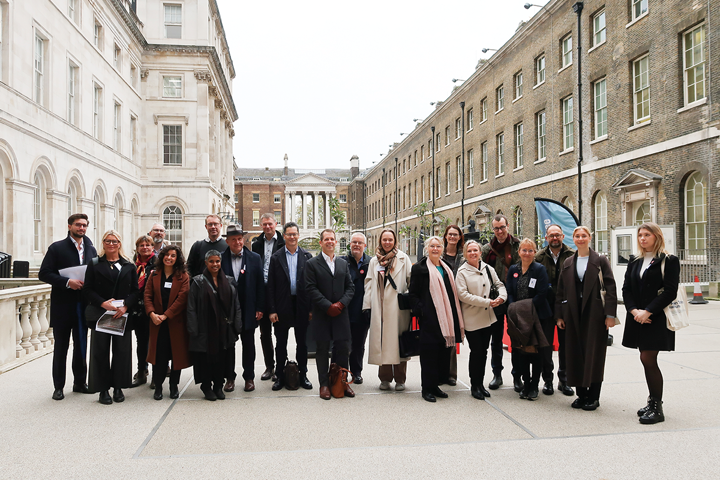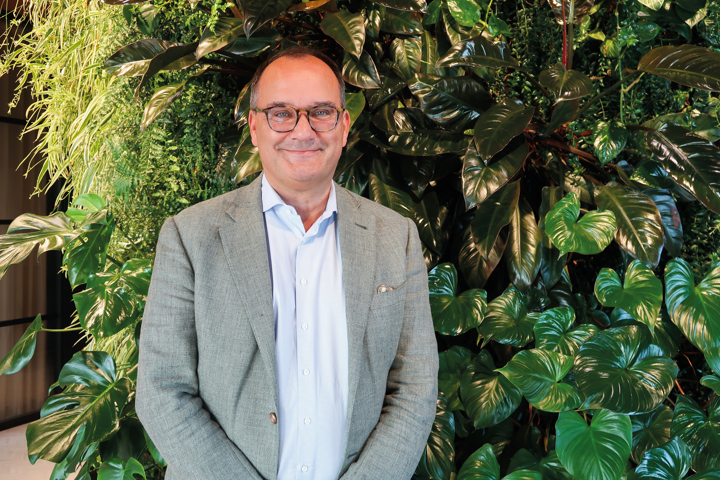
Giving buildings a new lease of life
24 January 2024
Property technology, often called proptech, is changing how we look at buildings at its very core. Instead of tearing them down, new technology is unlocking the potential of developing existing buildings by making them more energy-efficient, while enhancing the experience for the people using them. “Proptech has grown massively. I think we’re at the beginning of a very steep curve that will revolve around the reduction of energy use and more intelligent use of energy, combined with providing better and higher quality environments for people to work inside,” says Martin Reeves, Development Director at Oktra.
Oktra is an office design and build company with almost 30 years’ experience in planning, designing, and constructing workspaces for its clients. With four offices in the UK and around 200 employees, the company offers services stretching from feasibility studies and workplace strategies to architectural design, construction, as well as AV, IT, and furniture. “We aim to provide a complete environment for all of our clients, whether they are staying in the same space and reinventing themselves or leaving to find a new address. So, we try to look after every single facet of that process.”
A shift in how we look at buildings
Earlier this year Martin got involved in the Chamber’s Ecosystem Exchange: Proptech programme, sharing his expertise and insights to a group of aspiring Swedish proptech businesses looking to explore opportunities on the UK market.
He says that there has definitely been a shift in how we look at buildings in terms of their construction, fabric, and materials. “Let’s say 20 years ago, we would be perhaps more focused on building new buildings and making new things. There is a definite change in the last five years or so into reinventing existing buildings, refurbishing, and bringing them back to life,” he explains. “The reasons for this are around carbon footprint, and embodied carbon in the existing building structure – it’s seen as more valuable to try to reuse and recycle rather than to simply demolish and send building materials to landfill.”
This is where proptech systems come into the picture, playing a huge role in optimising the use of existing buildings. According to Martin, proptech can be described as a technology that enhances the fabric of the buildings that they already occupy, for example by using additional sensors to measure activity and usage of rooms and spaces. “But increasingly, proptech is interested in changing the way property uses energy, reducing energy use and operating costs associated to heating, lighting, and water usage. We want to achieve a better-quality environment, but at the same time, use less energy doing so. And proptech is a means to access those benefits.”
A humanistic and energy-saving approach
The way workspaces are designed today, reflects on the vast variety of spaces that is needed and a more humanistic approach has been adopted in recognising the needs of different people. “We want to make sure that people can have different types of environments and spaces to work in, according for the work that they do, and the type of person that they are,” Martin says and elaborates: “Not everyone works their best in the open plan and not everyone works their best in a small office. Not everyone works their best in a noisy environment, just as not everyone works their best in a very quiet library kind of environment.”
A recent example of how a both humanistic and energy-saving approach comes to play, is Oktra’s client Gymshark, a sportswear brand based near Solihull in the Midlands. As the business was growing, it needed larger and more sophisticated premises catering for the diverse needs of its growing number of staff. “One of the innovations that we brought into the environment, were more intelligent lighting systems which respond to the users and the number of users in an environment, and the types of spaces that they were in. The lighting systems offer automatically and intelligently adjusted light levels and coloration to offset mental fatigue and stop people from becoming unnecessarily tired. So, we use less energy, but we alleviate mental fatigue.”
AI – the next big leap
Martin predicts that AI will be the next big leap within proptech, making buildings more intelligent with the use of data. “We used to use security barriers to record the amount of people that were in buildings for health and safety purposes. I think with AI, we will go way beyond that. It becomes this ball of data that we will use not only to look at how many people are in a building, but how the building can respond to the people that are in it, to raise the level of their experience.”
And AI could very well pose one of the most interesting opportunities for proptech businesses to explore. “AI is definitely the next big thing that’s going to be integrated more and more. I think it is the biggest gap in the proptech market for sure.”
Commercial advantages driving the development
While Martin can see many similarities in the development of proptech in Sweden and in the UK, one of the main differences is the natural environment of the two countries. “We have a fairly temperate environment in the UK. Summers aren’t that hot, and winters aren’t really that cold.” But because of the country’s dense population, attention needs to be put on the expenditure required to run buildings and create infrastructure, which is always passed on to the tenants, developers, and landlords – ultimately Oktra’s clients. “So, any commercial advantage that people can find through the use of proptech, will make it more popular.”
He continues: “I think Sweden has known about environmental change and has taken an advanced position in how efficient buildings can become and how they manage energy, probably a little bit ahead of us.”
As an example, Martin brings up a project where a university in central England chose air source heat pumps developed in Sweden, when reevaluating its heating and cooling systems. “They looked to Sweden because they were more efficient, and that was just a simple procurement analysis for them. It feels like there is definitely something to be learned from Swedish technology development that we can take advantage of in the UK.”



Join our mailing list
and keep up-to-date with the Chamber's news and events.
Read our Privacy Policy here